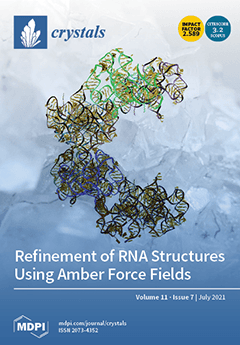Recently, the electrical conductive electrolyte based on flexible polymeric films have been attracted much attentions, due to their applications in batteries, thermoelectrics, temperature sensors and others. In this regard, two polymeric electrolytes (PVA/LiCl) and (PVA/AgNO
3) films have been engineered and the influence of the dopants and the annealing temperature on the structural, morphology and ac and dc conductivities is extensively studied. It was found that the films crystallinity has the order PVA/AgNO
3 (49.44%) > PVA (38.64%) > PVA/LiCl (26.82%). Additionally, the dc conductivity of the films is increased with embedding the dopants into the PVA as the order PVA/AgNO
3 (13.7 × 10
−4 S/cm) > PVA/LiCl (1.63 × 10
−5 S/cm) > PVA (1.71 × 10
−6 S/cm) at 110 °C. It is also found that there is a sharp increase for
σac as the frequency increases up to 10
7 Hz and also as the temperature increases to 110 °C. However, the order of increasing the
σac is PVA/LiCl (155 × 10
−3 S/cm) > PVA/AgNO
3 (2.5 × 10
−5 S/cm) > PVA (2 × 10
−6 S/cm) at
f = 10
7 Hz and 110 °C. The values of exponent are 0.870, 0.405 and 0.750 for PVA, PVA/AgNO
3 and PVA/LiCl, respectively, and it is increased as the temperature increases for PVA and PVA/LiCl, but it is decreased for PVA/AgNO
3. The activation energies
Ea are 0.84, 0.51 and 0.62 eV for PVA, PVA/AgNO
3 and PVA/LiCl, respectively. Moreover, the values of activation energy for charge carrier migration
Em are 0.60, 0.34 and 0.4 eV for PVA, PVA/AgNO
3 and PVA/LiCl, respectively. By using a simple approximation, the carrier concentration, carrier mobility and carrier diffusivity are calculated, and their values are increased as the temperature increases for all samples, but they are higher for PVA/LiCl than that of PVA/AgNO
3. These results are discussed in terms of some obtained parameters such as hopping frequency, free volume and chain mobility. Interestingly, the conduction mechanism was found to be the electronic charge hopping for PVA and PVA/LiCl films, however it was found to be the ionic charge diffusion (
n < 0.5) for PVA/AgNO
3 film. It has been predicted that these electrolytic films have a prospective applications in batteries design, temperature sensors, electronic and wearable apparatuses at an affordable cost.
Full article





